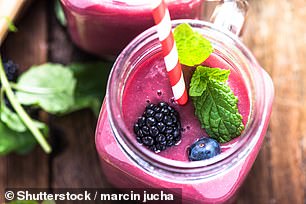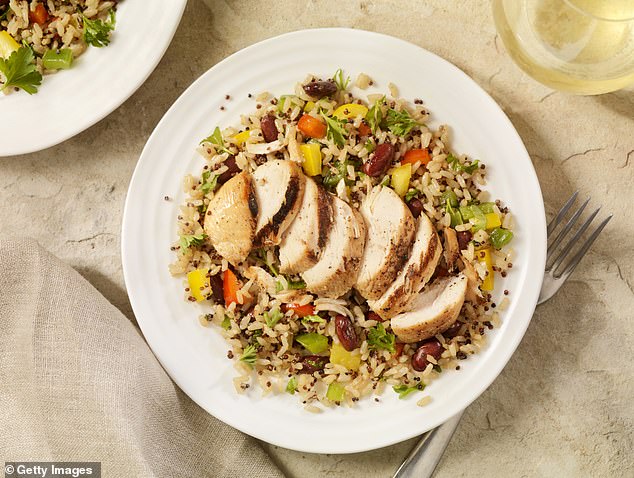The human body is chock full of hormones – from those that control reproduction to cognition.
One major hormone is cortisol, the body’s built-in ‘alarm system’ that is triggered in a response to stress or danger.
In small doses, cortisol can be helpful. It wakes you up, keeps you sharp, and helps you escape danger, but too much can also cause weight gain, poor sleep, and anxiety.
Foods that can trigger a rise in cortisol tend to increase blood sugar levels. When someone drinks sugary sodas and juices, eats refined carbs, and loads up on caffeine, the ensuing spike in blood sugar causes a release of cortisol as the body’s way of regulating it.
A balanced diet, however, can help regulate cortisol levels. Nutritionists and dietitians say one of the best ways to lower stress levels is to eliminate trigger foods, including those high in added sugar, caffeine, and heavily processed foods.
Experts highlighted the role that an anti-inflammatory diet can play, emphasizing foods such as leafy greens, avocados, and dark chocolate.
Additionally, foods rich in Omega-3 fatty acids, such as salmon, walnuts, and flax seeds, and whole grains and antioxidant-rich foods, such as blueberries, raspberries, and strawberries, can all be beneficial.
Kathleen Lopez, a New Hampshire-based nutrition expert at Rhythm Nutrition, told DailyMail.com: ‘If the diet lacks nutrients – amino acids, fatty acids, electrolytes, vitamins, and adequate carbs – this can cause an activation of the sympathetic nervous system, what’s known as fight or flight.’

Cortisol is the hormone produced in response to danger. Nutritionists recommend that one of the best ways to lower cortisol levels by maintaining a diet rich in anti-inflammatory foods, including salmon, nuts, leafy greens, and avocados
She added: ‘The standard American diet lacks protein, non-oxidized fatty acids, minerals, and vitamins.
‘When whole/real foods like meat, vegetables, fruit in moderation, and minimally adulterated carbohydrates – like fresh sourdough bread, potatoes, or whole oats – are consumed, this can support a more consistent parasympathetic tone.’
Dietitians and nutritionists have shared some of their favorite meals, incorporating a variety of foods that, when consumed as part of a healthy diet, can help lower cortisol levels.
Dr Carolyn Williams, a registered dietitian based in Alabama, told DailyMail.com: ‘In general, an anti-inflammatory diet will be your best bet. The Mediterranean diet is a great example.’
Foods promoted as part of the Mediterranean diet are the same foods that someone should eat while experiencing stress, especially chronic stress.
These include fish, vegetables, nuts and legumes, whole grains, and healthy fats.
Lopez cautioned that no single food can lower cortisol levels, but maintaining an anti-inflammatory diet can help regulate them.
In addition to adhering to a diet similar to the Mediterranean diet, exercising regularly, getting a recommended seven to nine hours of sleep, and practicing deep breathing can also help lower cortisol levels.
Below, Dr Williams shared some of her favorite recipes for managing cortisol levels.

Dr Carolyn Williams, an expert in anti-inflammatory diets, shared some of her favorite recipes with DailyMail.com

Berry green smoothie
Prep time: 5 min; serves 1

Dr Williams’ berry green smoothie contains blueberries and spinach, two cortisol-regulating foods
1 cup frozen wild blueberries or mixed berries1 container (5.3oz to 7oz.) of plain low-fat Greek yogurt or plain soy yogurt1/2 cup packed fresh baby spinach2 Tbsp. fresh orange juice2 Tbsp. water1 ripe banana, sliced
Put all ingredients in a blender; cover and blend until smooth. Serve immediately.
Per 2-cup serving: 305 calories; 3g fat; 18g protein; 54g carb; 8g fiber; 23g sugars; 63mg sodium
Chicken fried quinoa
Prep time: 15 min; serves 4
1 ½ Tbsp. sesame oil½ lb boneless, skinless chicken thighs, cut into 1/2-inch pieces½ cup chopped red bell pepper½ cup chopped green onion2 garlic cloves, minced1 tsp minced fresh ginger2 ½ cups cooked quinoa, cooled¾ cup frozen shelled edamame, thawed1 large egg, lightly beaten¼ cup gluten-free, lower-sodium soy sauce or tamariCrushed red pepper (optional) 
Garlic and ginger, sesame oil, and edamame make the chicken fried quinoa a great option for keeping stress levels in check and preventing a blood sugar spike (stock)
Heat 1 Tbsp oil in a large skillet over medium-high heat. Add chicken; cook, stirring frequently for 4 minutes.
Add bell pepper, green onion, garlic, and ginger; cook, stirring frequently until chicken is no longer pink and vegetables are tender for about three minutes. Transfer the chicken mixture to a plate and wipe the skillet clean.
Heat the remaining ½ Tbsp oil in the skillet over medium heat. Add quinoa and edamame; cook, stirring constantly, until thoroughly heated, about two minutes. Push the quinoa mixture to one side of the skillet. Add egg to opposite side of skillet and cook, stirring until scrambled, about one minute.
Add chicken mixture and soy sauce to skillet; cook, stirring frequently, until heated through, about one minute. Sprinkle with crushed red pepper (if using).
Per cup: 316 calories; 12g fat; 22g protein; 30g carbs; 5g fiber; 3g sugars; 732mg sodium
Zucchini taco skillet
Prep time: 30 min; serves 4
1 tsp olive oil¾ lb lean ground beef1 ½ Tbsp taco seasoning¾ tsp kosher salt1 (14.5-oz) can no-salt-added fire-roasted tomatoes, with juices1 (14.5-oz) can no-salt-added black beans, rinsed and drained1 cup fresh or frozen corn kernels (about 2 ears)½ cup water3 cups zucchini spirals1 ½ oz cheddar cheese, shredded (about 1/3 cup)¼ cup chopped green onion
Heat oil in a large skillet over medium heat.
Add the beef; cook for four minutes, stirring to break up the lumps. Increase heat to medium-high. Add Taco seasoning and salt; cook, stirring often, until meat is browned, about two minutes more.
Stir in tomatoes, beans, corn, and water; bring to a simmer, stirring occasionally. Simmer until slightly thickened, about five minutes.
Stir in zucchini. Reduce heat to medium-low and cook, covered, until zucchini is just tender, about three minutes. Divide among four bowls. Top with cheese and green onion.
Per 1 ⅓ -cup serving: 345 calories; 12g fat; 29g protein; 30g carbs; 8g fiber; 7g sugars; 527mg sodium
Sheet pan honey-soy salmon, sweet potatoes, and green beans

Salmon is a great source of Omega-3 fatty acids, nutrients shown to help modulate cortisol
Prep time: 45 min; serves 4
1 ½ Tbsp gluten-free lower-sodium soy sauce or tamari3 Tbsp olive oil1 Tbsp honey1 Tbsp fresh lime juice2 cloves garlic, minced4 (5-oz.) skin-on salmon fillets1 lb sweet potatoes, cut into 3/4-inch cubes½ tsp kosher salt½ tsp black pepper12 oz fresh green beans, trimmed
Preheat oven to 400 degrees Fahrenheit. Line a 13×18-inch baking pan with foil and coat with cooking spray.
Whisk together soy sauce, 1 Tbsp oil, honey, lime juice, and half of the garlic in a large bowl. Add salmon and turn to coat.
Arrange sweet potatoes on the prepared pan. Drizzle with 1 Tbsp oil and sprinkle with ¼ tsp each salt and pepper; toss to coat.
Roast until potatoes are almost fork-tender, 20 to 25 minutes.
Your browser does not support iframes.
Meanwhile, toss green beans with the remaining 1 Tbsp oil and the remaining garlic. Sprinkle with remaining ¼ tsp each salt and pepper; toss to coat. Remove the pan from the oven, stir, and then push the sweet potatoes to one end of the pan.
Arrange the marinated salmon in the center of the pan, skin-side down. (Reserve marinade for sauce, if desired.)
Spread green beans in the remaining portion of the pan. Roast until vegetables are tender and fish flakes, 15 to 17 minutes.
If desired, stir together reserved marinade and 3 Tbsp water in a small saucepan. Bring to a boil. Reduce the heat and simmer, uncovered, for at least 5 minutes or until the desired consistency is reached.
Serve with salmon and vegetables.
Per serving (1 fillet and 1 cup vegetables): 438 calories; 19g fat; 32g protein; 34g carbs; 6g fiber; 12g sugars; 513mg sodium
